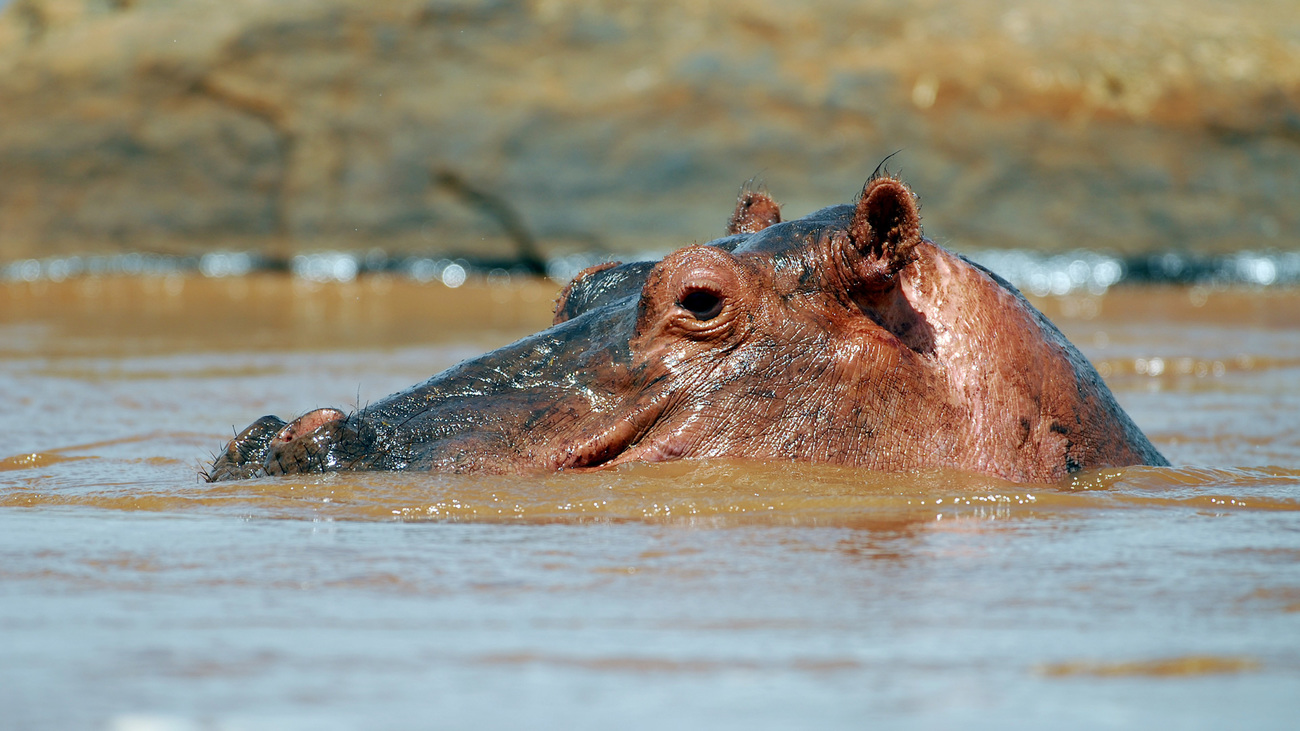Hippopotamuses
The hippopotamus is an amphibious mammal found in the heart of Africa’s wetlands. These semi-aquatic creatures live in and around lakes, rivers, and grassland swamps. There are two species of hippopotamuses, the common river hippopotamus (Hippopotamus amphibious) and the smaller pygmy hippopotamus (Choeropsis liberiensis).
Hippos must keep their skin wet with mud or water for most of the day to stay hydrated. While they don’t have sweat glands, they secrete a red substance called blood sweat. This helps protect their reddish-brown, thick yet sensitive skin from sunburn and keeps it moisturised. Despite their need to spend most of their time in the water, hippos can’t swim. Instead, they run or walk along river beds. When they’re rafting—napping while submerged in water—a subconscious reflex keeps them near the water’s surface.
These formidable creatures are considered the second largest land mammal, smaller only than elephants. The average male hippo can weigh around 3,200 kilograms, while females usually weigh 30% less. They’re typically 3.5 metres long and 1.5 metres tall.
Hippos have bulky, barrel-shaped bodies, short and stout legs, large heads, and enormously powerful jaws. Their jaws can open to 180 degrees and bite down with three times the strength of a lion. They’re armed with impressive, sharp teeth that can grow up to 50 centimetres long, used for eating and defence. The common hippopotamus has four webbed toes adapted to support them on land and in water. On the other hand, pygmy hippos tend to have less webbing and slightly longer legs. A hippo’s eyes and nostrils sit on top of its head, which helps it stay mostly submerged in water while breathing and keeping an eye on its surroundings. Although hippos can’t breathe underwater, they can hold their breath for up to five minutes.
Hippos exhibit strong social bonds and typically live in groups with anywhere from 40 to 200 hippos, known as bloats, pods, or herds. They are territorial creatures and use their dung to mark their territory. Male hippos have been known to flick their dung around to assert dominance. This dung is actually important to their aquatic ecosystems, as it transfers vital nutrients from the land to the water, allowing insects, plants, and other microorganisms to flourish.
The hippopotamus plays a crucial role in the ecosystem it inhabits in other ways, too. These herbivores graze on the vegetation surrounding wetlands, helping prevent overgrowth, which can clog water sources, disrupt the natural flow of water, and threaten the biodiversity of aquatic ecosystems.
Healthy wetlands act as effective carbon sinks and remove excess carbon from the atmosphere. By maintaining the balance of these delicate ecosystems, hippos help mitigate the effects of climate change.
Hippos are facing several threats to their survival as a species. Global conservation efforts are critical to ensuring the well-being of the species and the ecosystems it inhabits.
What is a hippo’s scientific name?
The scientific name for the common or river hippo is Hippopotamus amphibius. The word hippopotamus comes from the Greek words for horse (hippo) and river (potamos), so ‘river horse’ is an apt nickname.
The preferred plural form of hippopotamus is ‘hippopotamuses’, though it’s also acceptable to use ‘hippopotami’.
Are hippos endangered?
The common hippopotamus has been listed as vulnerable on the IUCN Red List since 2006, meaning it is not endangered. Their population is currently stable, meaning it’s neither increasing nor decreasing.
The pygmy hippopotamus is classified on the IUCN Red List as endangered and has also held that status since 2006. The pygmy hippopotamus population is decreasing, with less than 2,500 mature individuals currently remaining.
Where do hippos live?
Common river hippopotamuses are native to sub-Saharan Africa. They live in waterways like rivers, lakes, swamps, and estuaries. These semi-aquatic mammals can be found in various African countries, with populations in both East and West Africa.
Pygmy hippos, unlike their larger relatives, are found in the tropical rainforests and swamps of four West African countries: Côte d'Ivoire, Guinea, Liberia, and Sierra Leone. Their slightly smaller bodies have adapted to allow them to easily navigate the vegetation in rainforests.
Threats
Hippos face several threats that jeopardise their existence. From the depths of their aquatic homes to the savannahs and rainforests, hippos confront challenges brought about by human development within natural ecosystems, including poaching, habitat loss, and human-wildlife conflict.
Hippos also have a low birth rate, producing a single offspring every two years. This slow birth rate means more needs to be done to reduce the threats to their population to ensure the species survives.
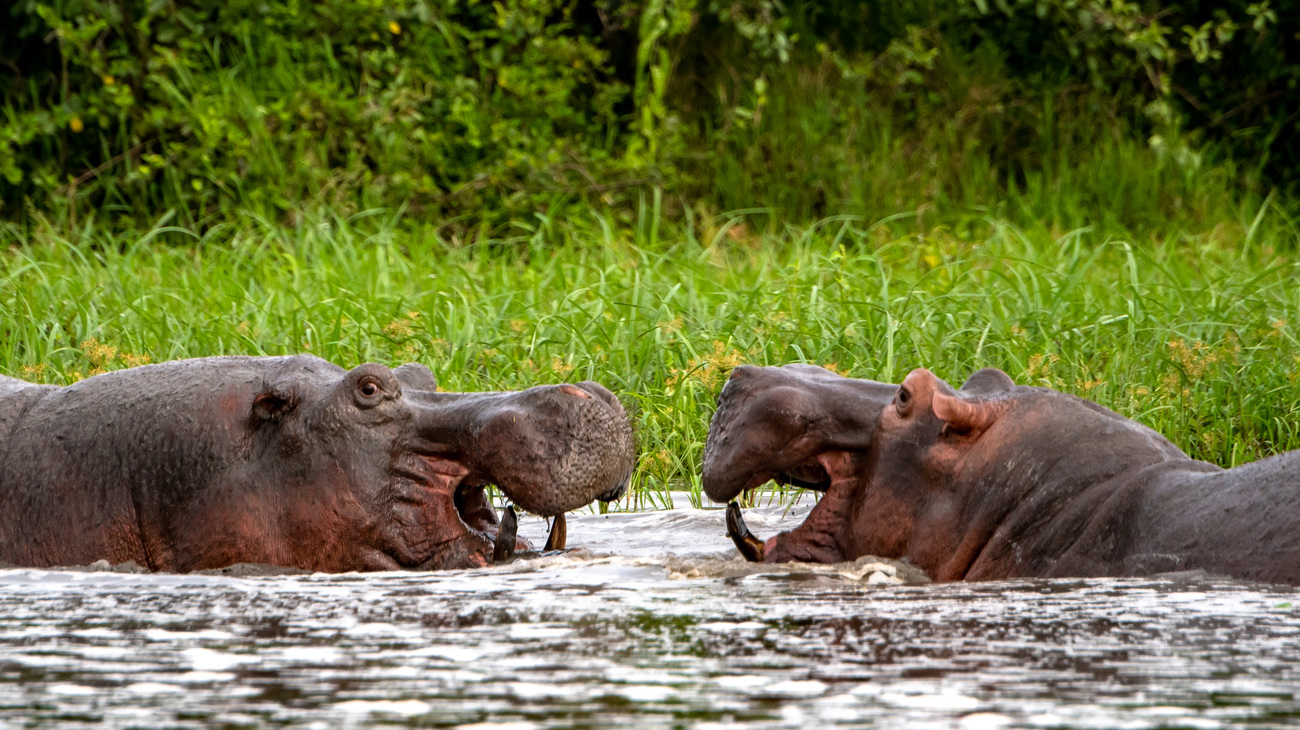
Poaching
Poaching, driven by a demand for ivory (of which hippo teeth are made) and meat, poses a significant threat to the population of hippos. Although the ivory trade is often associated with elephants, hippos’ canines can grow up to 50 centimetres long, which makes them a highly sought-after source of ivory.
Similar to elephant tusks, hippo teeth are used for decorative purposes. As restrictions on the elephant ivory trade increase, more poachers are turning to hippopotamus teeth as a replacement because they are often cheaper and easier to obtain.
Unfortunately, the body parts of hippos can still be traded under the Convention on International Trade in Endangered Species (CITES). Between 1975 and 2017, 770,000 kilograms of hippo teeth were traded legally. Those numbers don’t account for illegal trade.
Beyond ivory, hippo meat is sought after for its perceived nutritional value and cultural significance. This demand is a key driver behind illegal hunting and overhunting.
Habitat loss
As human populations expand, they continue encroaching further upon the natural habitat of hippos, leading to habitat loss. The waterways that make up the homes of common river hippos are often impacted by agriculture, fishing, infrastructure development, and urban expansion. Any minor changes to these waterways or their surrounding vegetation can significantly impact the delicate balance on which hippos rely for their survival.
Pygmy hippos are also affected by habitat loss, as they face the threat of deforestation. Clearing forests for agriculture and logging destroys their habitats, reduces their critical food supply, and removes their shelter.
Human-wildlife conflict
As human populations continue to expand into their inhabited areas, hippos face the threat of increased human-wildlife conflict.
Hippos are known for fiercely protecting their territories and will react aggressively to humans entering their space. This poses a great risk to humans who may unknowingly enter hippo territory by boat or on land. Hippos make for dangerous opponents in a confrontation due to their massive size, strength, and ability to reach speeds of 22 miles per hour on land.
Because of the proximity between some human communities and hippo habitats, hippos can sometimes wander into human-inhabited areas, looking for food. If a hippopotamus finds itself on farmland eating crops, it may be killed in retaliation.
These conflicts are becoming more frequent as humans and hippos continue to come into closer proximity.
FAQs
What is a group of hippopotamuses called?
A group of hippos is called a bloat, pod, or herd of hippos.
The plural of hippopotamus is ‘hippopotamuses’, but ‘hippopotami’ is also acceptable.
What do hippos eat?
Hippos are primarily herbivores, and their diets consist mainly of plants.
They usually leave the water at sunset to begin grazing. Grasses comprise the bulk of their diet—a hippo eats up to 110 pounds of grass per night. Considering their size, they consume a relatively small amount of food—just 1 to 1.5% of their body weight per day. This is mainly due to their sedentary lifestyle.
Sometimes hippos will venture several miles to find food. They use their ears to listen for the sound of falling fruit and use their noses to sniff out more food. Hippos also eat aquatic plants, using their lips and jaws to tear them out of the riverbeds.
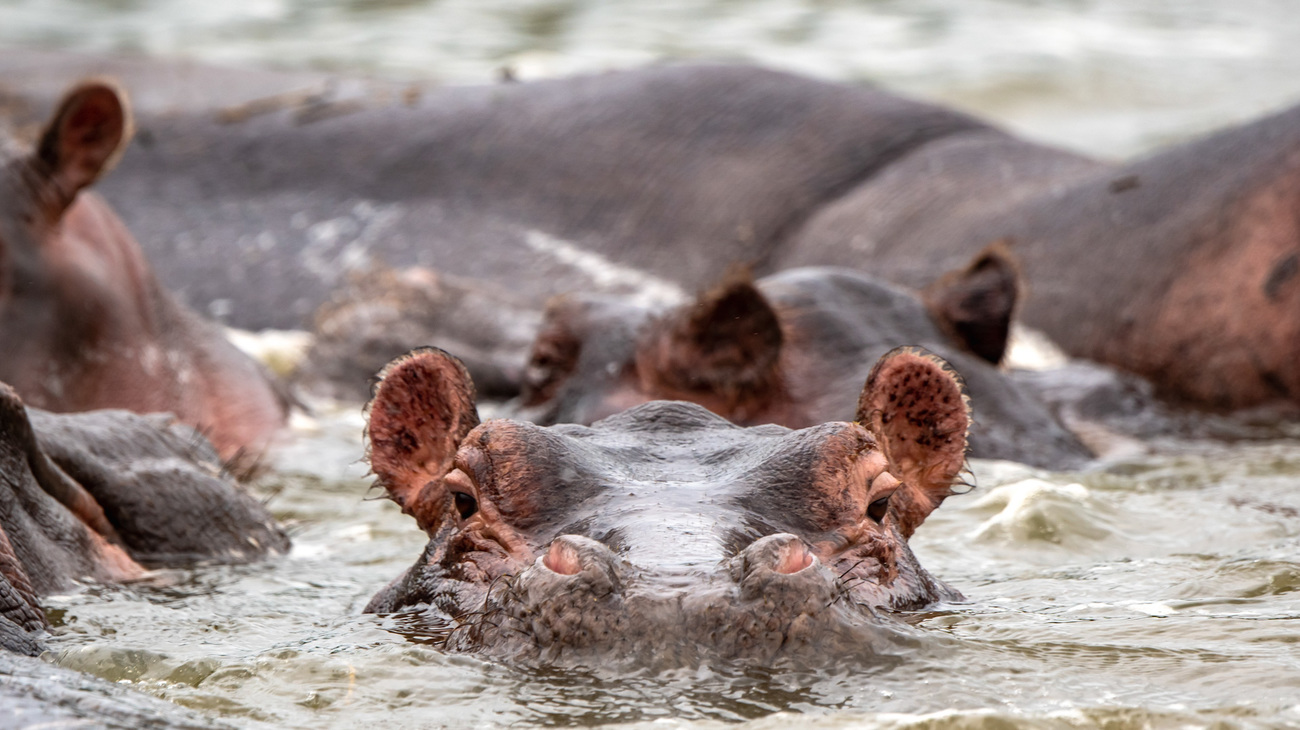
Why are hippos so aggressive?
Hippos are known for their aggressive and dangerous behaviour. In an encounter with a hippo, a human has an 86.7% chance of fatality. Because of their large size and weight, hippos are not as fast as other animals and will often rely on aggression as a primary defence mechanism. Their exceptionally strong teeth and jaws can be fatal weapons.
Hippos are highly territorial creatures, known to defend their habitats from intruders. Hippos are also protective over their young. Mothers often step up to protect their children from potential predators.
There are social hierarchies within groups of hippos, especially among males. The males will often have dominance battles, especially during mating season as they compete for access to female hippos.
What animal eats hippos?
Adult hippos have few predators because of their large size and aggressive nature. However, some animals still attempt to prey on hippopotamuses.
Lions sometimes attack young or weakened hippos, especially if they have been separated from their herds. Crocodiles also pose a natural threat when they inhabit the same bodies of water as hippos. In some rare cases, hyenas have scavenged on hippo carcasses or taken advantage of weakened hippos.
How much do hippos weigh?
Male hippos weigh around 3,200 kilograms, while females typically weigh around 2,240 kilograms.
Where do hippos live?
Hippos are found in sub-Saharan Africa. Common river hippos live in and around bodies of water like rivers, lakes, and mangroves. Pygmy hippos are primarily native to the tropical rainforests and swamps of a few countries in West Africa: Côte d'Ivoire, Guinea, Liberia, and Sierra Leone.
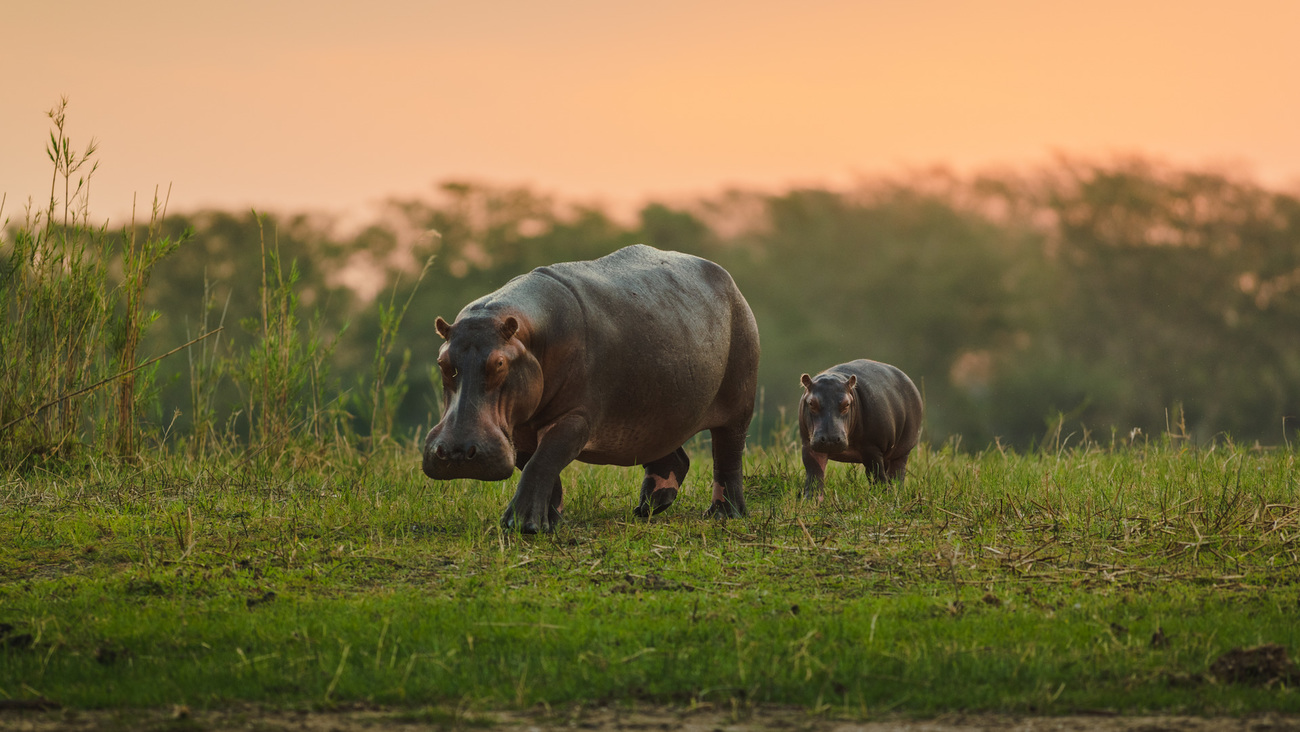
Can hippos swim?
No, hippos can’t swim, despite spending most of their time submerged in water. Unlike most mammals, their bodies are so dense that they can’t even float. To move in the water, they run or walk along river beds.
However, they can hold their breath underwater for up to five minutes.
How fast are hippos?
Hippos can run at speeds of 22 miles per hour on land, though they can’t run very long distances.
How long do hippopotamuses live?
In the wild, a hippopotamus can live to be up to 40 years old. In captivity, they can live up to 61 years.
What colour are hippopotamuses?
Hippopotamuses have greyish-brown skin with some pink patches.
What is the bite force of a hippo?
Hippos have a bite force of 1,800 pounds per square inch. That’s stronger than the bites of bull sharks, gorillas, polar bears, and jaguars. For context, a human’s bite force is around 162 pounds per square inch.
What to do if you see a hippo
It’s very dangerous to encounter a hippo. If you do see a hippo, you should give it plenty of space. Hippos aren’t naturally aggressive towards humans but will be aggressive if they feel threatened or if you’re in their territory. Ensure you don’t get in between a hippo and its food or water source.
Shouting or making loud noises is unlikely to deter a charging hippo. Your best bet is to seek refuge behind or up a tree.
Our work
IFAW supports local community members in collecting and reporting information about poaching incidents in protected areas. These volunteers care deeply about conserving local wildlife and work closely with intelligence units to prevent wildlife poaching and trafficking. Some are even former poachers who have realised that the benefits of protecting animals outweigh those of killing them.
These volunteers are trained with the skills and tools needed to protect their local ecosystems. With their help, we can ensure that snares and traps are promptly removed when they are spotted.
Between August and October 2022, thanks to the work of our volunteers, thirteen suspected poachers were arrested with two firearms and a tonne of hippo meat.
IFAW has also worked to protect hippos under amendments to the Ivory Act of 2018. These amendments made importing ivory from hippopotamus teeth to the UK illegal.
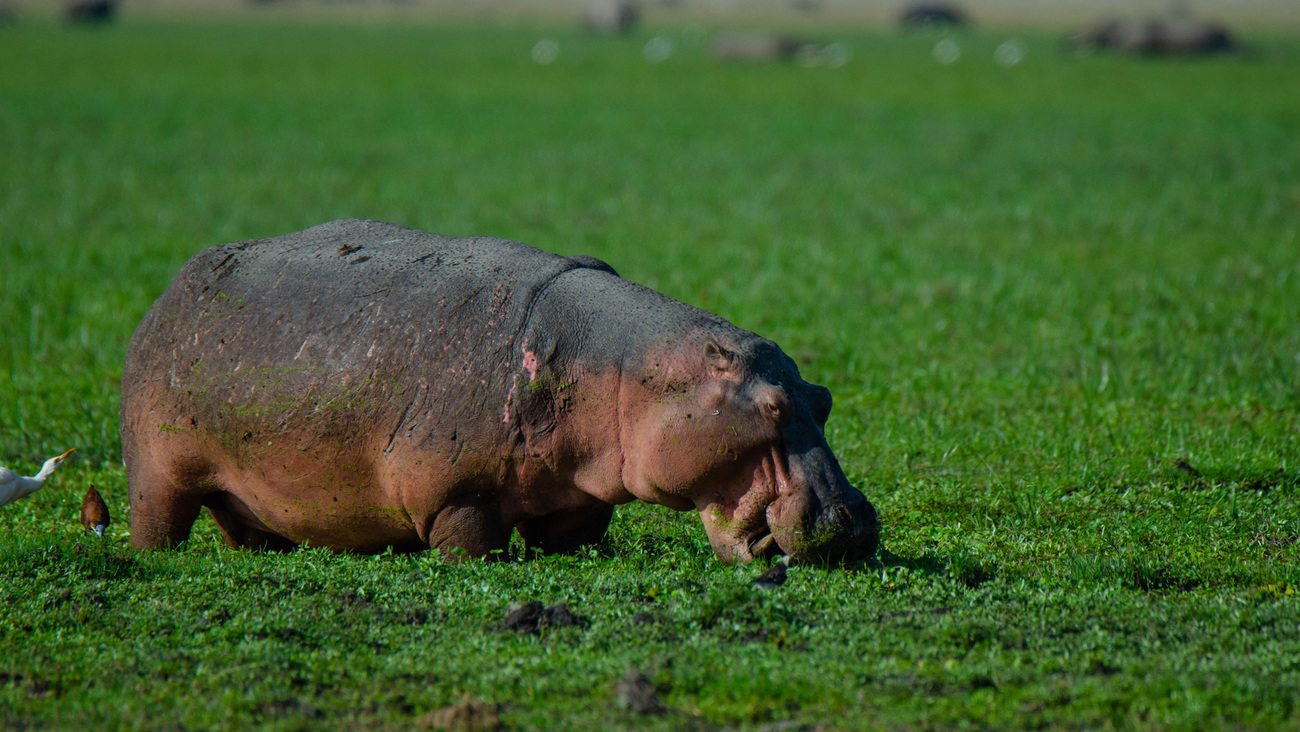
How can you help?
Hippos are threatened by poaching, habitat loss, and human-wildlife conflict. IFAW is working to combat these issues.
